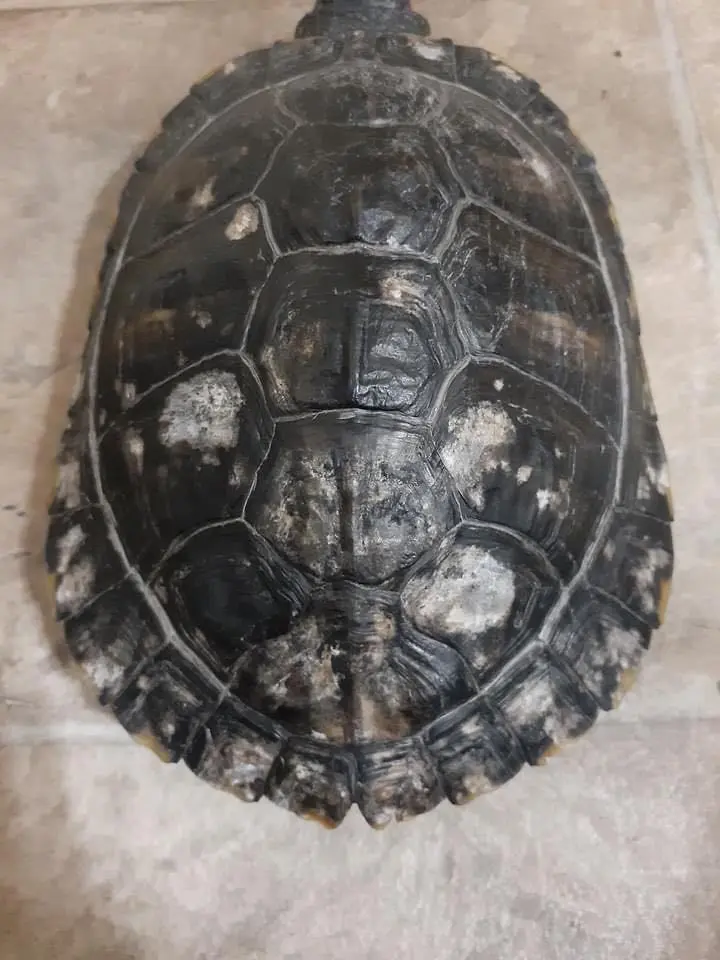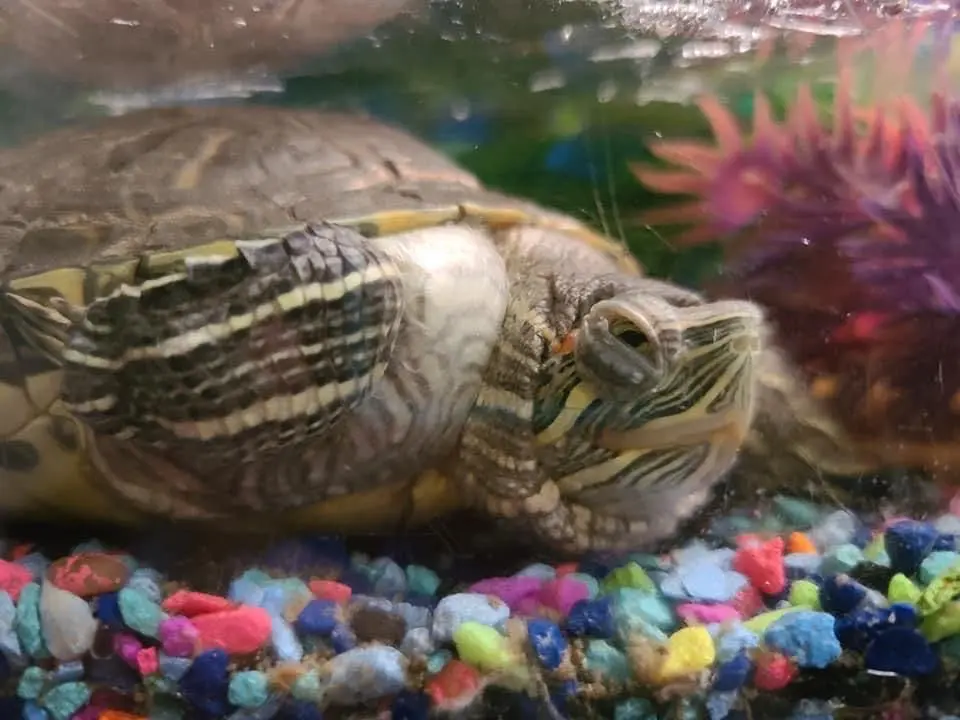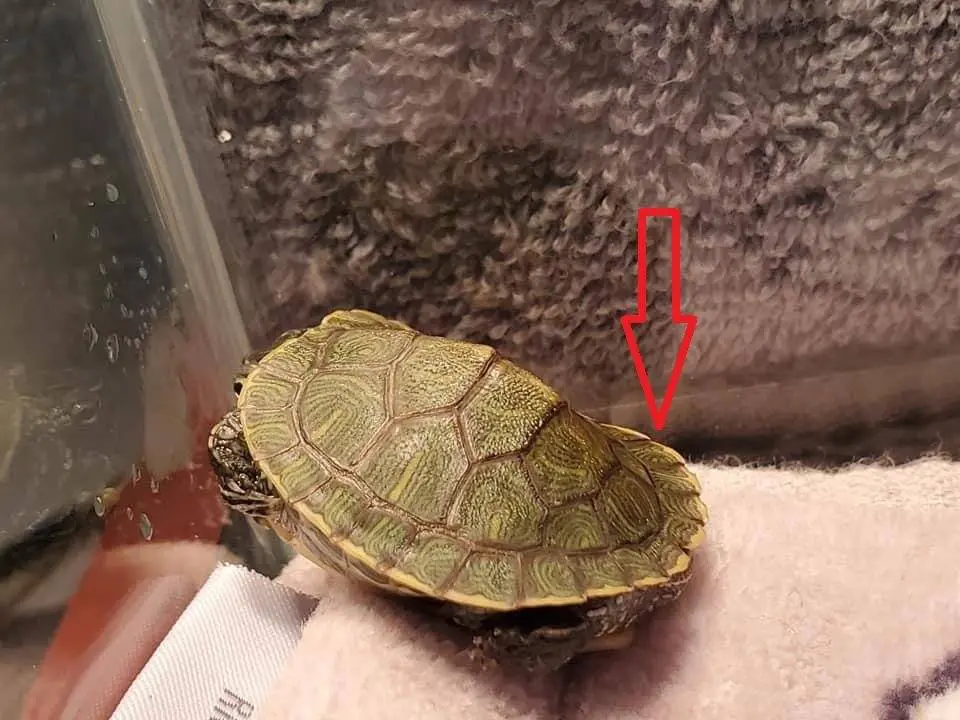Being a red-eared slider pet owner, you want to ensure the best for your pet. There are times when you may notice something isn’t quite right and are wondering what the problem could be.
Continue reading below for some of the common sick symptoms your red-eared slider may get and how to identify them.
Weight Loss
One of the most common causes of weight loss in red-eared sliders is parasites. Parasites, such as roundworms are common in these turtles with an infestation causing serious digestive problems.
In mild cases, you may not notice any sick signs or symptoms, but when the case becomes extreme, you may notice weight loss, lack of appetite, diarrhea, and lethargy in your red-eared slider.
Sores and Holes in Shell

Red-eared slider shell rot
The most common cause of holes and sores in the shell of your red-eared slider is shell rot. Shell rot is a shell infection that cause be caused by bacteria or fungus.
This is often due to living in unsanitary conditions or being injured. This allows dangerous bacteria to get into the shell.
The sores and holes you see on the shell may have a bad odor.
Swollen Eyes

Red-eared slider swollen eyes
If you notice your red-eared sliders eyes are swollen, there could be two reasons behind this:
Respiratory Infection
Red-eared sliders are prone to respiratory infections. This is often a result of incorrect temperatures in the tank, which leaves your turtle in colder conditions for too long.
There are some clear signs your pet may have a respiratory infection which includes lethargy, reduced appetite, sneezing, or making rasping sounds. Other signs are runny eyes and swollen eyes.
Vitamin A Deficiency
Vitamin A deficiency is a common problem in captive red-eared sliders, often a result of not having enough Vitamin A in the diet. This causes problems with organ function, skin function and can result in swollen eyes.
Ear Swelling
Ear infections, also known as aural abscesses, are relatively common in red-eared sliders. The good news is that they are quick and easy to diagnose with the obvious swelling of the ears. This can happen in one or both ears.
The swelling is a result of pus that forms in the ear canal and pushes on the skin. At this stage, your pet may have some discomfort, which will result in a lack of appetite. 90% of ear infections are due to poor habitat conditions.
Gray or Uneven Skin Pigmentation
If you notice gray patches or fuzzy white areas on your pet’s skin, this may be a fungal infection.
In addition to the gray or uneven pigmentation, there may be peeling, blisters, flaking, and pussy like substances on the skin.
This is often a result of poor quality combined with incorrect basking areas and temperatures.
Shell curving up

Red-eared slider shell curling up
One of the early signs of metabolic bone disease in red-eared sliders is the shell curving upwards. Metabolic bone disease can be caused by numerous factors, which results in a lack of vitamin D3 and calcium in the diet.
In addition to the shell curving upwards, there are a host of other sick signs and symptoms which could point towards metabolic bone disease (or soft shell) in a red-eared slider turtle.
These symptoms include:
- Curved limbs
- Lethargy
- Muscle twitching
- Jerky movements
- Seizures
- bumps on the bones of the legs
- Swollen limbs
- Softening of the shell
- Shell curving upwards
- Pyramiding
- Splayed legs
- Problems walking
- Crooked nails
- Distorted beak
- Fractures in bones
- Cloacal prolapse
Ensure you provide adequate UVB lighting to help your pet produce Vitamin D3 to encourage calcium absorption to prevent the risk of metabolic bone disease.
Jagged Shell Edges
You may notice the edges of your pet’s shell are looking jagged, which can be very normal and should disappear right after a shed. But it can also be due to overfeeding with retained scutes, giving your pet a jagged shell look.
Hanging Skin
Hanging skin is usually a result of dehydration, malnutrition, irregular shell growth, and poor habitat conditions.
Ensure you provide your pet with a clean enclosure with fresh and clean water. Disinfect the entire enclosure once every two to three weeks with regular daily spot checks and topping up of water. Always provide fresh, clean drinking water on a daily basis.
Provide a well-balanced diet of animal and plant matter, combined with aquatic plants and vegetables, such as carrots, green beans, and leafy greens.
Pyramiding
Pyramiding is a term used for the upward growth of the scutes on the shell of your pet. This means each scute has a pyramid or bumpy shape. The main cause is overfeeding.
Hatchlings should be fed daily. You can add vegetables and greens into their diet, even though they may not eat them. Offer daily pellets with a variety of protein sources.
Juveniles should be fed every second day with pellets and once a week they should be given protein. You can offer greens, even though at this stage they may not eat them. Still ensure you continue to offer them.
Adults should have mainly vegetables in their diet, they need less protein as they age. Adult red-eared sliders should be fed every other day or three times per week. They should be offered protein once to twice per week. As they get older reduce their protein to once a week.
Not Pooping
If you see your red-eared slider isn’t pooping, there could be two reasons. The first is constipation, which isn’t overly serious. Simply add more greens to the diet with plenty of warm soaking baths to get the digestion going again.
Impaction, on the other hand, can be very serious. This is when your pet accidentally eats some substrate when eating their food, ingesting sand or dirt causes a blockage. Impaction will usually require veterinary treatment.
Diarrhea
Diarrhea is relatively common in red-eared sliders. Your pet’s poop should be dark and firm. Diarrhea can be caused by eating fruit to a diet low in fiber. It can also be caused by parasites.
If you see your pet has diarrhea and you have other turtles, ensure you place your pet in a quarantine tank for observation and until it is healthy to return to its own enclosure. If the poop is green and runny, you may want to visit the vet for treatment.
Something is wrong with my pet turtle 🐢.he is not going to sleep 💤 like he normally does. Juliana Griffin
my turtle has red lips I don’t know if it’s bad. please tell me
🙁
My turtle has these red lines in between its shell pieces. This wasn’t there a week prior.